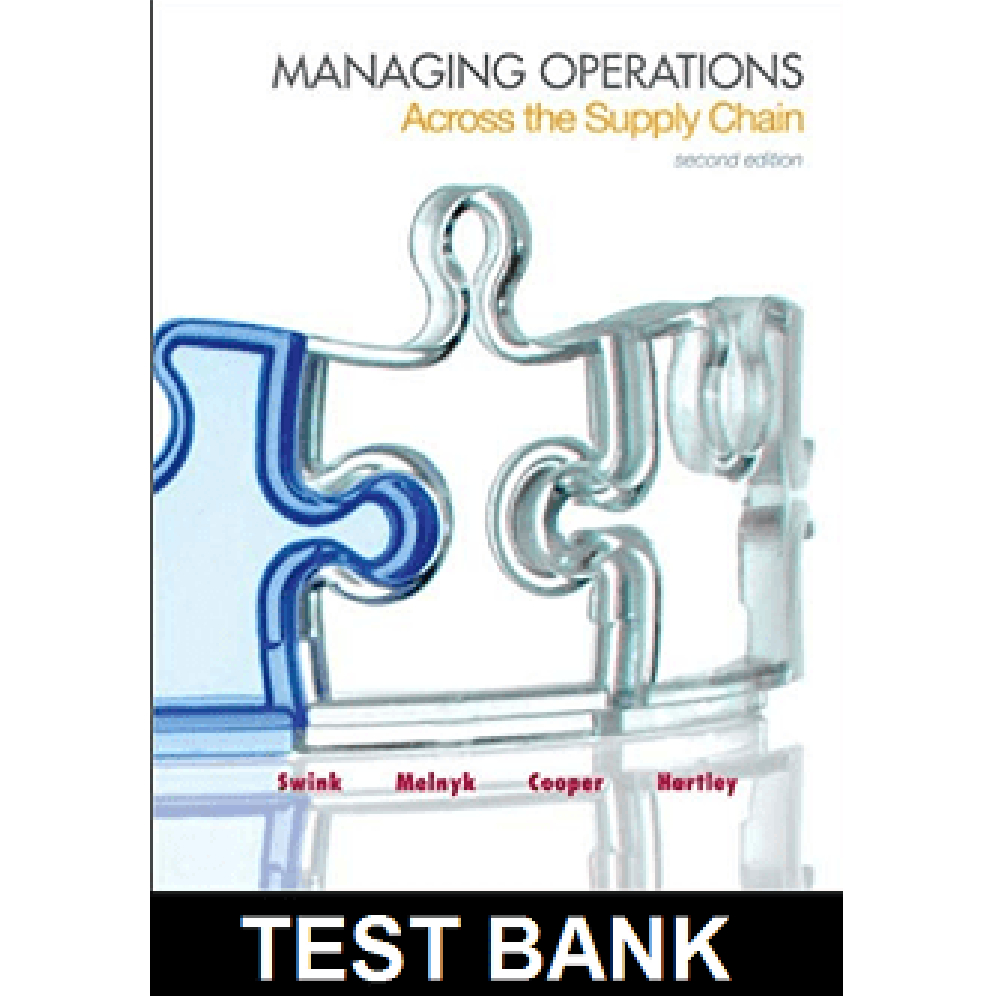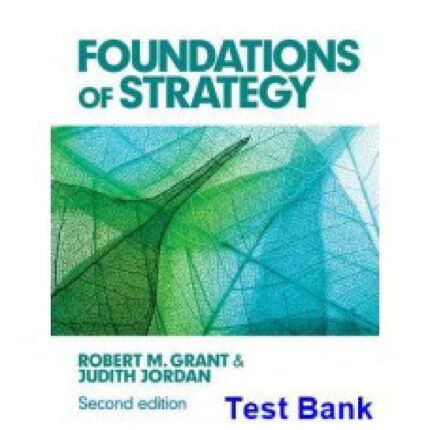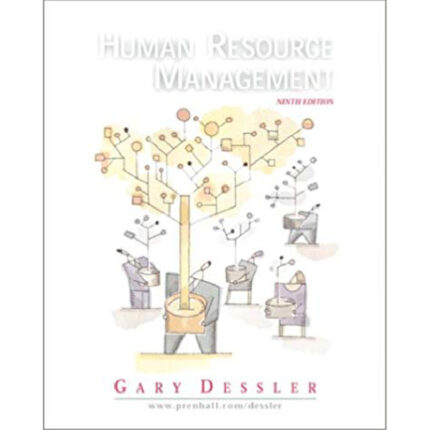Managing Operations Across the Supply Chain 2nd Edition By Swink – Test Bank
Multiple Choice Questions
1. Zanda Corp. made a decision to use a more expensive mode of transportation to deliver orders to customers. This decision was likely made after an examination of
A. Cost-to-cost tradeoffs.
B. Consolidation strategies.
C. Product availability problems.
D. Cost-to-service trade-offs.
Increasing cost to improve service performance represents a cost-to-service trade-off.
AACSB: Reflective Thinking
Blooms: Apply
Learning Objective: 11-01 Explain logistics and the major decisions made by logistics managers.
Level of Difficulty: 2 Medium
Topic Area: The Role of Logistics in Supply Chain Management
2. Which of the following best describes the concept of total landed cost?
A. The sum of all logistics costs related to a product.
B. The lowest logistics cost for a product.
C. The sum of all product- and logistics-related costs.
D. None of these.
Total landed cost is the sum of all product- and logistics-related costs.
AACSB: Reflective Thinking
Blooms: Remember
Learning Objective: 11-01 Explain logistics and the major decisions made by logistics managers.
Level of Difficulty: 1 Easy
Topic Area: The Role of Logistics in Supply Chain Management
3. Zanda Corp. had established a production plant in Thailand. Recently it decided to close the plant and move production to Mexico. This decision was likely made after Zanda:
A. Conducted a spend analysis.
B. Conducted a make-or-buy analysis.
C. Examined total landed cost.
D. Evaluated consolidation strategies.
Total landed cost requires examination of all product- and logistics-related costs. This type of examination may result in decisions regarding the lowest-cost place for manufacturing.
AACSB: Reflective Thinking
Blooms: Apply
Learning Objective: 11-01 Explain logistics and the major decisions made by logistics managers.
Level of Difficulty: 2 Medium
Topic Area: The Role of Logistics in Supply Chain Management
4. With respect to transportation regulation today in the United States:
A. There is no economic regulation of transportation.
B. There is more economic regulation than ever before.
C. There is very little safety/social regulation.
D. There is more safety/social regulation than ever before.
There is still a small amount of economic regulation, but safety and social regulation has increased dramatically.
AACSB: Reflective Thinking
Blooms: Remember
Learning Objective: 11-03 Choose efficient transportation modes and carriers.
Level of Difficulty: 1 Easy
Topic Area: Transportation Management
5. Jones Company has decided to limit deliveries to selected areas to specific days of the week to obtain transportation savings. This is an example of:
A. Market consolidation.
B. Pooled delivery consolidation.
C. Scheduled delivery consolidation.
D. Transportation consolidation.
E. Poor planning.
This is the definition of scheduled delivery consolidation.
AACSB: Reflective Thinking
Blooms: Apply
Learning Objective: 11-02 Estimate cost savings from consolidation.
Level of Difficulty: 1 Easy
Topic Area: Transportation Management
6. Jones Company learned that several other shippers in its hometown had customers located in the same markets that it serves. With this information, Jones should investigate the possibility of:
A. Market area consolidation.
B. Scheduled delivery consolidation.
C. Pooled delivery consolidation.
D. All of these.
Because other shippers are involved in this question, pooled delivery consolidation is the most appropriate answer.
AACSB: Reflective Thinking
Blooms: Apply
Learning Objective: 11-02 Estimate cost savings from consolidation.
Level of Difficulty: 2 Medium
Topic Area: Transportation Management
7. Zanda Corp. can make three individual deliveries to three different customers at a cost of $500 each or can consolidate them into one shipment with a cost of $1,300 and a stop-off charge of $100 per stop. Should Zanda do this?
A. Yes, it will save $100.
B. Yes, it is simpler to do.
C. No, it will increase cost by $100.
D. It doesn’t matter based on cost.
$1,300 + 3($100) = 1,600, an increase in cost of $100.
AACSB: Analytic
Blooms: Analyze
Learning Objective: 11-02 Estimate cost savings from consolidation.
Level of Difficulty: 2 Medium
Topic Area: Transportation Management
8. Miller Corp. can make three individual deliveries to three different customers at a transportation cost of $600 each or can consolidate them into one shipment with a transportation cost of $1,200 and a stop-off charge of $100 per stop. Should Miller Corp. consolidate the shipments?
A. Yes, it will save $100.
B. Yes, it will save $300.
C. No, it will increase cost by $100.
D. It doesn’t matter based on cost.
Nonconsolidated cost = $600(3) = $1,800.
Consolidated cost = $1,200 + $100(3) = $1,500. Consolidation saves $300.
AACSB: Analytic
Blooms: Analyze
Learning Objective: 11-02 Estimate cost savings from consolidation.
Level of Difficulty: 2 Medium
Topic Area: Transportation Management
9. Suppose you are shipping 1,000 pounds of product to a customer location that is 500 miles away from you. The customer calls you and increases the order size to 10,000 pounds. Which of the following is NOT LIKELY to occur as a result of this change?
A. The cost per pound of transportation for the order will decrease.
B. The total cost of transportation for the order will increase.
C. Both of these are likely to occur.
This consolidation is likely to both decrease the cost per pound of transportation and increase the total cost.
AACSB: Reflective Thinking
Blooms: Understand
Learning Objective: 11-02 Estimate cost savings from consolidation.
Level of Difficulty: 2 Medium
Topic Area: Transportation Management
10. With respect to the following operating service characteristics of the modes of transportation, which combination is INCORRECTLY specified?
A. Speed: air is best; pipeline is worst.
B. Availability: truck is best; pipeline is worst.
C. Capability: pipeline is best; water is worst.
D. Dependability: pipeline is best; air is worst.
Only C is incorrect. For capability, pipeline is worst, water is best.













Reviews
There are no reviews yet.